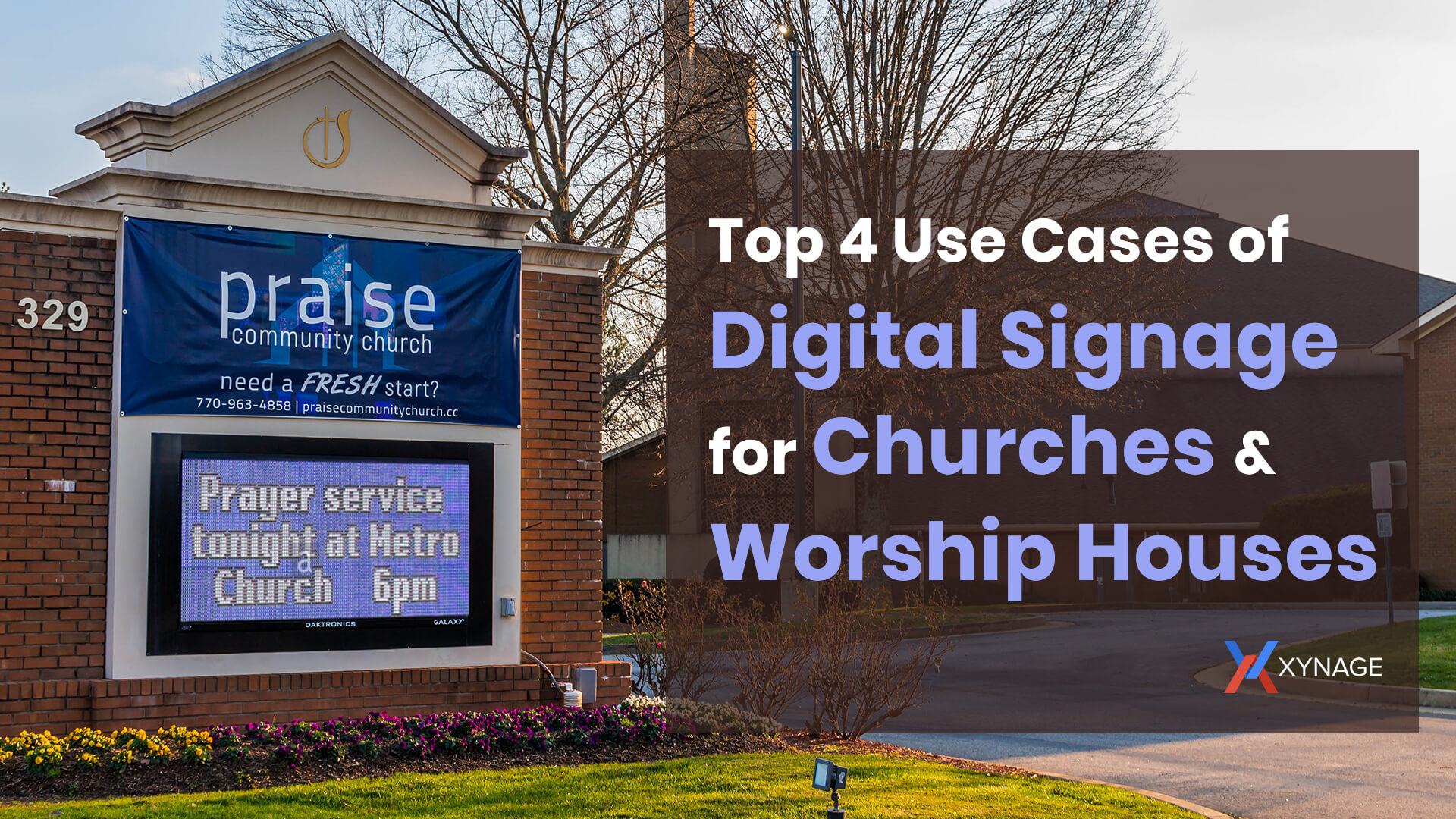If you want to engage a community, then effective communication is one of the most crucial steps to take for churches, temples, mosques, synagogues, and other places of worship.
Today, in many parts of the world, places of worship are experiencing a drop in membership and a lack of attendance from Gen Z.
To overcome this trend, religious institutions like churches have identified the need to embrace technology and reiterate the way they deliver messages via digital signage for churches.
Today, more than 80% of churches have a website, and almost 75% of sermons are using projectors. Digital signage is a fantastic advertising and marketing tool.
It offers a medium to communicate the message to your audience. Speaking of communication, most churches have two primary audiences: members of their community and members of their congregation.
Learn how digital signage for churches can help you effectively reach both audiences.
Digital signage for churches – use cases
1 – Community engagement
Digital signage for churches can have a crucial role in community engagement. The ability to welcome new members to the congregation with personalize messaging has a positive effect on the community.
Events like christening and baptism can be celebrated communally with a scrolling ticker on display. An unusually important type of announcement would be thanking and acknowledging donors to the church.
Such recognition generates goodwill and strengthens the community of religious people.
2 – Inspiring quotes and messages
The reputation of digital signage for churches increases as you start to depict inspirational messages. Specifically, venues of American churches are iconic for their billboard style welcome signs.
In the 21st century, inspirational quotes and messages are often shared via the Internet. There are several reasons that places of worship might want to go digital with their core messaging as well.
Rather than having the same maxim or principle showed on a traditional static sign, digital signs allow temples, mosques, synagogues, and churches to rotate their messaging effortlessly.
It also opens a new possibility of conveying scripture through non-textual mediums such as video.
3 – Event schedules
Churches and other houses of worship provide a diverse array of activities and events. Growing publicity and hence their attendance is a priority for every church organizer.
Digital signage for churches is an excellent way of promoting activities and events. Signage screens can be used to show schedules and bring attention to lesser-known events.
One-off events like wedding ceremonies would also benefit from this technology. Display content that is personalized to the marrying couple gives a special touch, with the possibility to showcase information like the order of service usefully.
4 – Broadcast messages
Recently, religious leaders giving sermons have started thinking out of the box. Traditional services where a minister would once hardly orate to his congregation have started offering other elements of media.
Digital signage for churches is an ideal vehicle for this evolution. Digital displays are a superior platform compared to projectors when it comes to showing images and videos.
Screens might be used to deliver content like YouTube videos. Equally, digital church signboards are priceless when it comes to accommodating attendees with hearing disabilities.
Another corresponding function of digital signage for churches is providing information about guest speakers or parish leaders.
Short biographies of a person’s background can help familiarise a congregation with their leaders and cultivate a greater sense of community.
Conclusion
Digital signage for churches, mosques, temples, etc. will play an increasingly significant role in modernizing the communication to engage a younger generation of congregants.
Digital signage for churches – General FAQs
1) Is digital signage for churches is an appropriate choice?
Probably your church is growing rapidly, and you have a hundred young, tech-savvy families attending every week/weekend.
Or, on the contrary, possibly your church is in a town with a few hundred people, and fewer people take pride in stopping by the church every Monday afternoon, rain or shine, to change the message on your rusty old signboard that was installed in 1955.
The fact that a digital church sign makes sense for you depends on your budget and situation.
2) How does digital signage for worship houses work?
Unlike a traditional signboard with changeable letters, digital signage requires a source of electricity and an Internet connection either wired via a cable, wireless, or cellular networks to upload graphics and messages.
In addition to the church management software that manages daily operations of your church, digital signage comes with its own CMS (content management software) that lets you manage the signage content.
One of the most significant benefits of a digital church sign is directly related to its software. While it might take an hour to overwrite your message on a traditional sign, one can change the message on the digital signage in just a few moments.
3) How much does digital signage for churches cost?
There are two significant reasons churches tend to choose to stick with traditional signs rather than upgrading to digital.
The first is the ease of use. Anyone can change a box of letters out to signage and spell out messages. On the other hand, digital signage has a built-in learning curve when it comes to operating the software and display the message on the screen.
The second is cost. For a traditional sign, you can expect to pay several thousand dollars, while a new LED signboard will cost you at least $20,000 – $30,000.
4) How can I get the maximum out of my digital church signage?
Below are the five ways you can get the most out of your digital signage:
- Keep the information updated
- Schedule messages from time to time
- Make it more informative than eye-catchy
- Spend enough time on the maintenance of the digital sign
- Spread smiles by displaying humorous content



